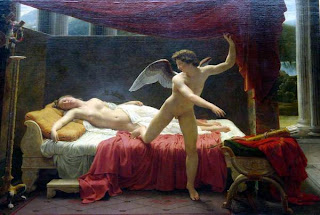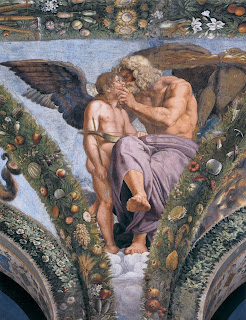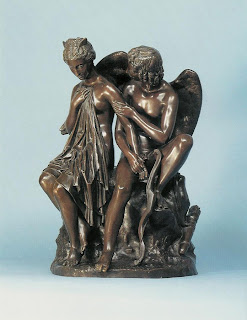Cupid and Psyche studying butterfly] (Hermitage) (1808
The fascinating legend of Cupid and Psyche (also known as The Tale of Amour and Psyche and The Tale of Eros and Psyche) first appeared as a digressionary story told by an old woman in Lucius Apuleius' novel, The Golden Ass, written in the 2nd century AD. Apuleius likely used an earlier tale as the basis for his story, modifying it to suit the thematic needs of his novel.
It has since been interpreted as a Märchen, an allegory and a myth. Considered as a fairy tale, it is either an allegory or a myth, but the folkloric tradition tends to blend these. We will explore the legend thru Art & decorative arts.
Eros/Cupid/Amor is often portrayed in art with wings (usually bird-like. The Dove was a symbol associated with his mother, Venus.) He usually carries a bow and a quiver of arrows. Sometimes he is shown blindfolded ("love is blind"). Eros is often shown as a putto, a young chubby winged figure. (These are commonly, and mistakenly, called "cherubs".) but he can also be shown as a young boy to a young man.
Psyche was a mortal Princess, renowned for her great beauty and her name means "breath" or "soul". She became the goddess of the Soul and is often portrayed as a lovely young beautiful woman, sometimes with butterfly wings. Sometimes Psyche and Eros/Cupid are shown as putti together. Here we go.
Once upon a time there was a king with three daughters. They were all beautiful, but by far the most beautiful was the youngest, Psyche. She was so beautiful that people began to neglect the worship of Venus, the goddess of love and beauty.
Cupid and Psyche, by Jean Baptiste Regnault, 1754-1829 (1828)
Envious and jealous of the beauty of a mortal girl named Psyche, Venus asks her son Cupid (known to the Greeks as Eros) to use his golden arrows while Psyche sleeps, so that when she awakens, Venus (Aphrodite in the Greek tradition) would have already placed a vile creature for her to fall in love with. Cupid finally agrees to her commands after a long (and failed) debate. As he flies to Psyche's room at night, he turns himself invisible so no one can see him fly in through her window. He takes pity on her, for she was born too beautiful for her own safety.
As he slowly approaches, careful not to make a sound, he readies one of his golden arrows. He leans over Psyche while she is asleep and before he can scratch her shoulder with the arrow, she awakens, startling him, for she looks right into his eyes, despite his invisibility. This causes him to scratch himself with his arrow, falling deeply in love with her. He cannot continue his mission, for every passing second he finds her more appealing. He reports back to Venus shortly after and the news enrages her. Venus places a curse on Psyche that keeps her from meeting a suitable husband, or any husband at that. As she does this, it upsets Cupid greatly, and he decides as long as the curse stays on Psyche, he will no longer shoot arrows, which will cause the temple of Venus to fall.
After months of no one — man or animal — falling in love, marrying, or mating, the Earth starts to grow old, which causes concern to Venus, for nobody praises her for Cupid's actions. Finally, she agrees to listen to Cupid's demands, according him one thing to have his own way. Cupid desires Psyche. Venus, upset, agrees to his demands only if he begins work immediately. He accepts the offer and takes off, shooting his golden arrows as fast as he can, restoring everything to the way it should be. People again fall in love and marry, animals far and wide mate, and the Earth begins to look young once again.
When all continue to admire and praise Psyche's beauty, but none desire her as a wife, Psyche's parents consult an oracle, which tells them to leave Psyche on the nearest mountain, for her beauty is so great that she is not meant for (mortal) man. Terrified, they have no choice but to follow the oracle's instructions. But then Zephyrus, the west wind, carries Psyche away, to a fair valley and a magnificent palace where she is attended by invisible servants until nightfall, and in the darkness of night the promised bridegroom arrives and the marriage is consummated. Cupid visits her every night to sleep with her, but demands that she never light any lamps, since he does not want her to know who he is until the time is right.
ORMOLU AND BRONZE CLOCK (c.1830)
Cupid allows Zephyrus to take Psyche back to her sisters and bring all three down to the palace during the day, but warns that Psyche should not listen to any argument that she should try to discover his true form. The two jealous sisters tell Psyche, then pregnant with Cupid's child, that rumor is that she had married a great and terrible serpent who would devour her and her unborn child when the time came for it to be fed. They urge Psyche to conceal a knife and oil lamp in the bedchamber, to wait till her husband is asleep, and then to light the lamp and slay him at once if it is as they said. Psyche sadly follows their advice. In the light of the lamp Psyche recognizes the fair form on the bed as the god Cupid himself. However, she accidentally pricks herself with one of his arrows, and is consumed with desire for her husband. She begins to kiss him, but as she does, a drop of oil falls from her lamp onto Cupid's shoulder and wakes him. He flies away, and she falls from the window to the ground, sick at heart.
Psyche then finds herself in the city where one of her jealous elder sisters live. She tells her what had happened, then tricks her sister into believing that Cupid has chosen her as a wife on the mountaintop. Psyche later meets her other sister and deceives her likewise. Each sister goes to the top of the peak and jumps down eagerly, but Zephyrus does not bear them and they fall to their deaths at the base of the mountain.
Psyche Receiving The First Kiss From Cupid, by Francois-Pascal-Simon Gerard, 1770-1837 (1798).
Psyche searches far and wide for her lover, finally stumbling into a temple where everything is in slovenly disarray. As Psyche is sorting and clearing the mess, Ceres (Demeter to the Greeks) appears, but refuses any help beyond advising Psyche that she must call directly on Venus, who caused all the problems in the first place. Psyche next calls on Juno in her temple, but Juno gives her the same advice. So Psyche finds a temple to Venus and enters it. Venus then orders Psyche to separate all the grains in a large basket of mixed kinds before nightfall. An ant takes pity on Psyche, and with its ant companions, separates the grains for her.
Psyche Crowning Cupid, by Jean-Baptiste Greuze (1786?)
Venus is outraged at her success and tells her to go to a field where golden sheep graze and to retrieve some golden wool. A river-god tells Psyche that the sheep are vicious and strong and will kill her, but if she waits until noontime, the sheep will go to the shade on the other side of the field and sleep; she can then pick the wool that sticks to the branches and bark of the trees. Venus next asks for water flowing from a cleft that is impossible for a mortal to attain and is also guarded by great serpents. This time an eagle performs the task for Psyche.
Venus, furious at Psyche's survival, claims that the stress of caring for her son, made depressed and ill as a result of Psyche's lack of faith, has caused her to lose some of her beauty. Psyche is to go to the Underworld and ask the queen of the Underworld, Proserpina (Persephone to the Greeks), to place a bit of her beauty in a box that Venus had given to Psyche. Psyche decides that the quickest way to the Underworld is to throw herself off some high place and die, and so she climbs to the top of a tower. But the tower itself speaks to Psyche and tells her the route that will allow her to enter the Underworld alive and return again, as well as telling her how to get past Cerberus (by giving the three-headed dog a small cake); how to avoid other dangers on the way there and back; and most importantly, to eat nothing but coarse bread in the underworld, as eating anything else would trap her there forever. Psyche follows the orders precisely, rejecting all but bread while beneath the Earth.
The Reunion of Cupid and Psyche, by Jean Pierre Saint-Ours, 1752-1809), (c1789-1792)
However, once Psyche has left the Underworld, she decides to open the box and take a little bit of the beauty for herself. Inside, she can see no beauty; instead an infernal sleep arises from the box and overcomes her. Cupid (Eros), who had forgiven Psyche, flies to her, wipes the sleep from her face, puts it back in the box, and sends her back on her way. Then Cupid flies to Mount Olympus and begs Jupiter (Zeus) to aid them. Jupiter calls a full and formal council of the gods and declares that it is his will that Cupid marry Psyche. Jupiter then has Psyche fetched to Mount Olympus, and gives her a drink made from ambrosia, granting her immortality. Begrudgingly, Venus and Psyche forgive each other.
Psyche and Cupid have a daughter, called Voluptas (Hedone in Greek mythology), the goddess of "sensual pleasures", whose Latin name means "pleasure" or "bliss".
Psyche and Cupid, by Joseph Berger, 1798-1870 (1820-1860?)
Psyche and Cupid, first edition wallpaper, Joseph Dufour, 1752-1827 (1815)
Psyche and Cupid, first edition wallpaper, Joseph Dufour, 1752-1827 (1815)
Cupid fleeing the sleeping Psyche, by Francois-Edouard Picot (1786-1868) (1817
Cupid and the Three Graces by RAFFAELLO SANZIO
Cupid and Psyche (Amor und Psyche) Lauritz Prior, Danish, 1840 - 1879 Cupid and Psyche. 1865
Cupid and Psyche by SIR ANTHONY VAN DYCK
Amor und Psyche / Amor and Psyche ARTIST: Antonio Canova
Cupid and Psyche by ORAZIO GENTILESCHI
Psyche Abandoned by AUGUSTIN PAJOU 1790
The Toilet of Psyche (Psyché à sa toilette), oil on canvas painting by Natoire created in 1735,
Banquet of Cupid and Psyche by GIULIO ROMANO
Banquet of Cupid and Psyche by GIULIO ROMANO
Zephyr a Psyche by HENRI-JOSEPH RUXTHIEL 1814
Banquet of Cupid and Psyche by GIULIO ROMANO
Cupid and Psyche by CLAUDE-AUGUSTIN CAYOT
The Wedding Banquet of Cupid and Psyche. Artist: Pierre Courteys (French, ca. 1520-ca. 1586). Date (Period): 1567. Medium: painted enamels on copper
The Story of Psyche by CHARLES-JOSEPH NATOIRE
Psyche Revived by Cupid's Kiss
1760's Sèvres Porcelain statue of Psyche
Cupid and Psyche, by Benjamin West, oil on canvas, 1808
Wedding Banquet of Cupid and Psyche
Venus and Cupid
Mercury
Cupid and the Three Graces
Psyche Gives Venus the Vessel
Cupid Pleads with Jupiter for Psyche
Mercury Brings Psyche up to Olympus
Psyche at the bath, A similar study, engraving attributed to Francesco Bartolozzi (c.1727-1815), after anonymous painting (late 18th century?)
Amor og Psyke genfornede I himlen, by Bertel Thorvaldsen, 1770-1844 (C.1807)
Cupid, by Antoine-Denis Chaudet (1763-1810), 1802-1807
Amore and Psyche in the National Museum of Rome (18th century)
Psyche looking at Cupid, (sculpture) by unidentified artist (18th century?)
Psyche Revived by Cupid's Kiss (Louvre) (1797)
French Empire Mantle Clock, after model by Claude Michallon (1810)
Galatea and Cupid, 1813 by Anne-Louis Girodet-Trioson
Psyche Contemplating Sleeping Cupid, Gobelins (1792)
Cupid and Psyche au bain Sculpture , tapestry by a Charles-Francois Poerson, 1653-1725, after Giulio Romano (1684-1686)
Psyche, by Wolf von Hoyer, 1806-1873 (c. 1842)
Psyche and Her Two Sisters, by A.E. Fragonard, 1780-1850 (1798)
Psyche, by James Pradier
L'Amour et Psyche, by James Pradier, also known as Jean-Jacques Pradier, 1790-1852 (ca. 1846-1852?)
Angelica Kauffmann -Portrait of prince Henri Lubomirski as Cupid, Museum of Liviv, Ukraine
Cupid and Psyche in the Heavens (1821)
[section of painting at the Villa Corsi Salviati], (17th century?).
Reunion of Eros and Psyche, by Thomas Griffiths Wainewright, 1794-1847 (1840-1844)
Cupid and Psyche (sculpture in the Summer Garden, SaintPetersburg) (late 18th century?)
Tout L'Olympe en Rumeur [All Olympus in a Hubbub], engraving after Raphael (second quarter nineteenth century)
[Psyche gazing at Cupid], by Simon Vouet, 1590-1649 (first half of the seventeenth century
Psyche asleep, 1807 by Anne-Louis Girodet-Trioson
The Nuptials of Cupid and Psyche, by Pelagio Palagi, 1775-1860 (1808)




































































































Hello. Very nice collection ! Thank you for sharing :)
ReplyDeleteDating for everyone is here: ❤❤❤ Link 1 ❤❤❤
DeleteDirect sexchat: ❤❤❤ Link 2 ❤❤❤
lg ..
Your welcome!
ReplyDeleteThanks this is an amazing work!!!So grateful.Judith
ReplyDeleteThe one you have labeled " Psyche Revived by Cupid's Kiss (Louvre) (1797) " is by Antonio Canova
ReplyDeleteThis comment has been removed by a blog administrator.
ReplyDeleteThis is very interesting, You’re a very skilled blogger. 온라인카지노
ReplyDeleteDating for everyone is here: ❤❤❤ Link 1 ❤❤❤
ReplyDeleteDirect sexchat: ❤❤❤ Link 2 ❤❤❤
8n. .